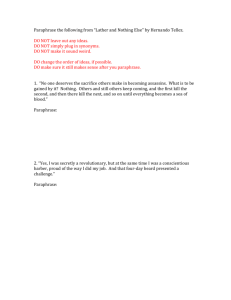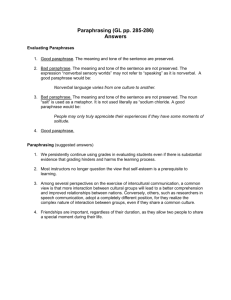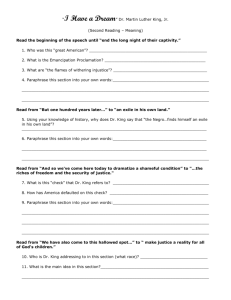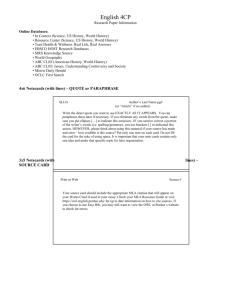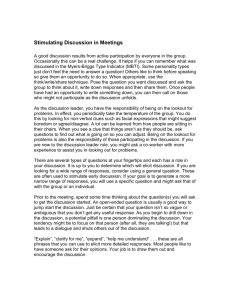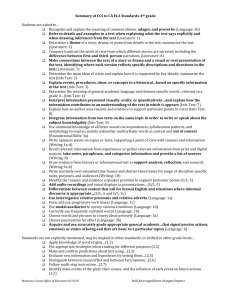When would you use wait time in your classroom?
advertisement
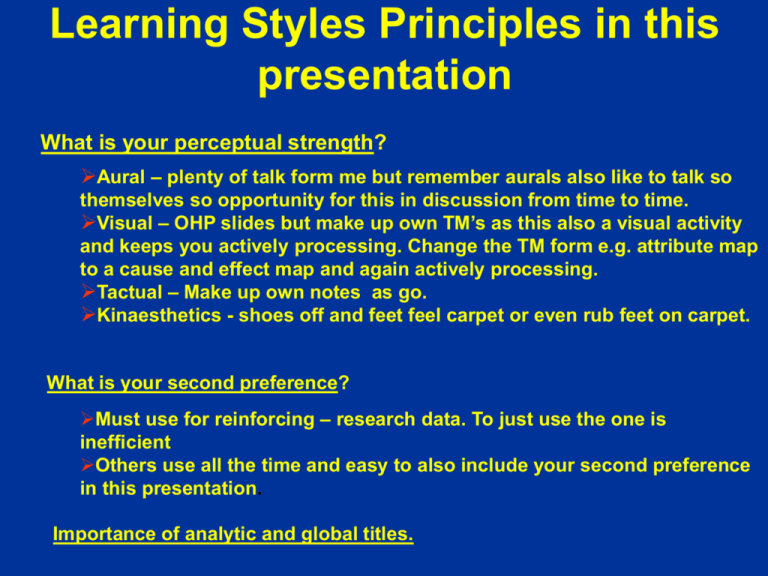
Learning Styles Principles in this presentation What is your perceptual strength? Aural – plenty of talk form me but remember aurals also like to talk so themselves so opportunity for this in discussion from time to time. Visual – OHP slides but make up own TM’s as this also a visual activity and keeps you actively processing. Change the TM form e.g. attribute map to a cause and effect map and again actively processing. Tactual – Make up own notes as go. Kinaesthetics - shoes off and feet feel carpet or even rub feet on carpet. What is your second preference? Must use for reinforcing – research data. To just use the one is inefficient Others use all the time and easy to also include your second preference in this presentation. Importance of analytic and global titles. Get the Process Right! Or Don’t Get Your Nose Out of Joint! Getting the right answers or A questionable practice! Mary Budd Rowe’s Research Two or three questions per minute Student response within .09 seconds Teachers asking questions Only one second before moving on Answered own questions Mary Budd Rowe’s Research Two or three questions per minute Student response within .09 seconds Teachers asking questions Only one second before moving on Answered own questions Mary Budd Rowe’s Research Wait Time – Minimum of 3 seconds Between announcing and asking a question Asking and calling on an answer Create Wait points Calling on a further to encourage that student to continue his/her response or response right of reply or for other students to give a considered response to the previous student and/or extend the idea. Calling on someone else to respond REFLECTION/RECODING - PMI Plus = The good things – WHY you like it Minus = The bad points – WHY you don’t like it Interesting = Neither good nor bad points but what you find interesting about the idea. TRIAD RESPONSE Ask question Call on y to agree or disagree: paraphrase then respond Wait Wait Call on X to answer Call on z to evaluate y’s comments paraphrase respond Evidence required Evidence required Allow x last word Teacher summary ???? Wait Wait Wait Wait PARAPHRASE RULES First give the main idea or big picture precisely Second add the most important details that support the main idea. Charles Handy “When I went to school, I did not learn anything much which I now remember, except the hidden message, that every major problem in life had already been solved. The answers were in the teacher’s head or in her textbook but not in mine ….. That hidden message from my school, I eventually realized, was not only crippling, it was wrong.” Wait Time/Silence gives time to: Reduce impulsivity Reflect or metacog Access prior knowledge Respond with precision and accuracy Striving for accuracy Thinking interdependently Listening with understanding and empathy REFLECTION/RECODING - PMI Plus = The good things – WHY you like it Minus = The bad points – WHY you don’t like it Interesting = Neither good nor bad points but what you find interesting about the idea. P3 Pause Paraphrase Personalise P3 Pause Pause Paraphrase Paraphrase Personalise Personalise Making Classrooms More Interrogative and Less Imperative Encourage students to answer questions sometimes without using words. Let students use materials such as colored pencils and rulers to graph or sketch their answers or as a Thinking Map. Mime Call on students randomly. Use a technique such as pulling Popsicle sticks with students' names on them from a jar. Replace the stick after every question and answer to assure randomness. Record who answers or takes part so equity The teacher's job is to manage and guide what occurs prior to and immediately following each period of silence so that the processing that needs to occur is completed. The teacher needs to be unobtrusive WAIT TIME PUTTING IT INTO EFFECT Rule one – after I have asked the question no one raises their hand until I call for the answer. Rule two – before responding to the previous speaker his/her comments are to be paraphrased. Rule three – the teacher takes no part except at the end, briefly. 1. Question – “When would you use wait time in your classroom?” 2. Wait 3. Call on someone to answer/respond. 4. Wait time/pause 5.Start answer with PARAPHRASE 6. Wait 7. Call on some one to evaluate the previous speaker. PARAPHRASE 8. Original person right of reply. PARAPHRASE 9. Optional teacher comment/summary WAIT TIME – THE RESEARCH CLASSROOM CLIMATE Discipline improves Teachers and students ask better questions (requiring higher order thinking skills) Student academic achievement improves thus expectancy rises for all BUT IT IS A LEARNED HABIT: A LEARNED PROCESS. IT WONT JUST HAPPEN IT HAS TO BE TAUGHT! MORE DETAILED RESEARCH Responses change from a single word to whole statements. The inflection on the end of the response that says, “Am I right?” disappears. Self-confidence increases. Speculative thinking increases. Guessing, “I don't know,” and inappropriate responses decrease. Students “piggyback” on each other's ideas. The interaction becomes a student-student discussion, moderated by the teacher, instead of a teacher-student inquisition. Students ask more questions. Students propose more investigations. Teachers ask fewer questions. University of Pennsylvania researchers, Angela L. Duckworth and Martin E.P. Seligman in the Journal Psychological Science state that: programs that build self-discipline may be the royal road to building academic achievement self-discipline and selfdenial could be a key to saving U.S. schools. These findings suggest a major reason for students falling short of their intellectual potential is their failure to exercise selfdiscipline. STIRLING UNIVERSITY Dr Gwyneth Doherty-Sneddon British Journal of Developmental Psychology "The mistake adults make is to interject too quickly, they need to try and hold back," said Dr DohertySneddon. "If they avert their gaze, it's worth waiting because they are probably trying to come up with something.” “What our research clearly shows was that primary-school-aged children used gaze aversion to help them concentrate on difficult material." She added: "It is something to be encouraged rather than discouraged." ANDERSON’S NEW BLOOM HIGHER ORDER THINKING SKILLS. Better responses leading to efficacy when ask higher order thinking questions. CREATING – generating new ways of viewing/doing How can wait time be applied to written work written work? EVALUATING – justifying alternative actions Where might wait time be useful in sports coaching? ANALYSING – distinguishing between combinations Would you get different results with a different year? APPLYING - using in a familiar combination When would you use wait time in class? UNDERSTANDING – explaining, justifying Why do you wait rather than taking the first hand up? Name the researcher associated with wait time? KNOWLEDGE – remembering DEVELOPS A MINI SYSTEM Teacher asks HL question Student gives HL response Student in turn asks HL ? Teacher gives HL response The power of teacher modeling but raise it to the consciousness level! Our success as teachers in helping students see themselves as competent in the subjects we teach will affect the rest of their lives Carol Ann Tomlinson “Waddya mean ‘not demonstrative enough’?.....only last week I said you were right up there with my dog!”
